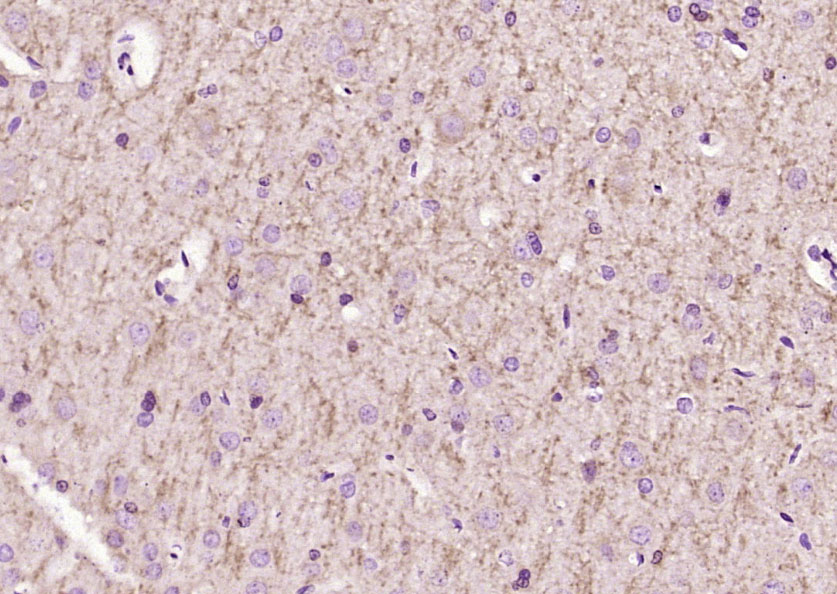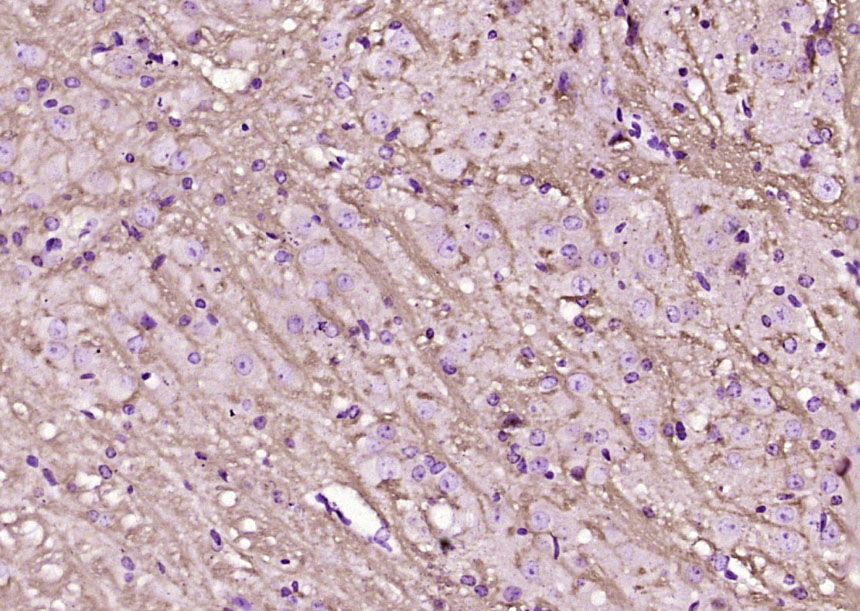
Rabbit Anti-LINGO1 antibody
FLJ14594; LERN 1; Lingo-1; LERN1; Lingo1; Leucine rich repeat and Ig domain containing 1; Leucine rich repeat neuronal protein 1; Leucine rich repeat neuronal protein 6A; Leucine-rich repeat neuronal 6A; Lingo 1; LRR and Ig domain-containing Nogo Receptor
View History [Clear]
Details
Product Name LINGO1 Chinese Name Nogo受体反应蛋白抗体 Alias FLJ14594; LERN 1; Lingo-1; LERN1; Lingo1; Leucine rich repeat and Ig domain containing 1; Leucine rich repeat neuronal protein 1; Leucine rich repeat neuronal protein 6A; Leucine-rich repeat neuronal 6A; Lingo 1; LRR and Ig domain-containing Nogo Receptor interating protein; Lrrn 6a; Lrrn6a; Lrrn6a protein; MGC17422; Nogo Receptor interacting protein; UNQ201. literatures Research Area Developmental biology Neurobiology Signal transduction Channel protein The cell membrane受体 G protein signal Immunogen Species Rabbit Clonality Polyclonal React Species Mouse, Rat, (predicted: Human, Chicken, Dog, Pig, Cow, Horse, ) Applications ELISA=1:5000-10000 IHC-P=1:100-500 IHC-F=1:100-500 IF=1:100-500 (Paraffin sections need antigen repair)
not yet tested in other applications.
optimal dilutions/concentrations should be determined by the end user.Theoretical molecular weight 70kDa Detection molecular weight 75-85 kDa Cellular localization The cell membrane Form Liquid Concentration 1mg/ml immunogen KLH conjugated synthetic peptide derived from human LINGO1: 521-620/620 Lsotype IgG Purification affinity purified by Protein A Buffer Solution 0.01M TBS(pH7.4) with 1% BSA, 0.03% Proclin300 and 50% Glycerol. Storage Shipped at 4℃. Store at -20 °C for one year. Avoid repeated freeze/thaw cycles. Attention This product as supplied is intended for research use only, not for use in human, therapeutic or diagnostic applications. PubMed PubMed Product Detail LINGO-1 (LRR and Ig domain-containing Nogo Receptor interating protein) is a nervous system-specific LRR-Ig-containing protein with an important role in CNS biology. LINGO-1 was discovered in a sequence database search for human SLIT homologs that were selectively expressed in the brain. LINGO-1 is a transmembrane protein that is a component of the Nogo-66 receptor complex. It binds NgR1 and p75 and is an additional functional componenet of the NgR1/p75 signaling complex.
Function:
Functional component of the Nogo receptor signaling complex (RTN4R/NGFR) in RhoA activation responsible for some inhibition of axonal regeneration by myelin-associated factors. Is also an important negative regulator of oligodentrocyte differentiation and axonal myelination. Acts in conjunction with RTN4 and RTN4R in regulating neuronal precursor cell motility during cortical development.
Subunit:
Homotetramer. Forms ternary complex with RTN4R/NGFR and RTN4R/TNFRSF19.
Subcellular Location:
Cell membrane; Single-pass type I membrane protein.
Tissue Specificity:
Expressed exclusively in the central nervous system. Highest level in the in amygdala, hippocampus, thalamus and cerebral cortex. In the rest of the brain a basal expression seems to be always present. Up-regulated in substantia nigra neurons from Parkinson disease patients.
Post-translational modifications:
N-glycosylated. Contains predominantly high-mannose glycans.
Similarity:
Contains 1 Ig-like C2-type (immunoglobulin-like) domain.
Contains 11 LRR (leucine-rich) repeats.
Contains 1 LRRCT domain.
Contains 1 LRRNT domain.
Contains 1 LRRNT domain
SWISS:
Q96FE5
Gene ID:
84894
Database links:Entrez Gene: 415344 Chicken
Entrez Gene: 84894 Human
Entrez Gene: 235402 Mouse
SwissProt: Q50L44 Chicken
SwissProt: Q6NUK3 Human
SwissProt: Q96FE5 Human
SwissProt: Q9D1T0 Mouse
Neurobiology相关蛋白(Neurobiology)
LINGO-1是一种体内体外少突胶质细胞(Oligodendrocyte)分化和髓鞘(myelination)的负调控因子,神经元上的LINGO-1被证明参与调节中枢神经再生的抑制信号,而少突胶质细胞表达的LINGO-1分子参与负调节少突胶质细胞的髓鞘化过程,是一种体内体外少突胶质细胞(Oligodendrocyte)分化和髓鞘(myelination)的负调控因子。Product Picture
Bought notes(bought amounts latest0)
No one bought this product
User Comment(Total0User Comment Num)
- No comment




 +86 571 56623320
+86 571 56623320
 +86 18668110335
+86 18668110335

